Introduction to Monjayaki
Monjayaki, also known simply as monja, is a classic dish from Japan and a renowned specialty of Tokyo. This savory Japanese cuisine falls under the category of pancakes, distinguished by its watery consistency compared to Okonomiyaki. The name of this dish can vary depending on the specific region where it is prepared. Essentially, it involves creating a batter by mixing wheat flour with water, which is then poured onto a hot iron plate for cooking.
Other than the Kansai-style Okonomiyaki, Hiroshima-style Okonomiyaki, and Negiyaki we have known so far, Monjayaki is part of them too. They are examples of savory Japanese-style pancakes. Now, let’s get to know what Monjayaki is.
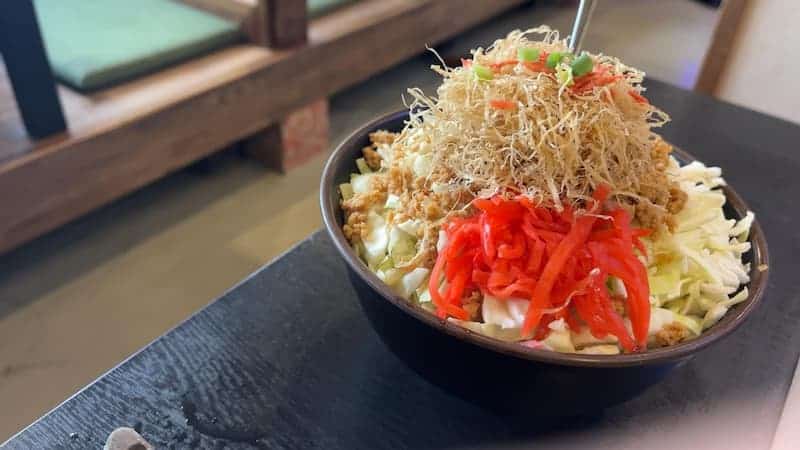
Etymology
Monyaki’s name came from a snack Japanese calls “Mojiyaki.” The name mojiyaki means “grilled letters” because children would come to this snack shop and practice writing letters in the gooey mojiyaki batter.
What is Monjayaki?

Monjayaki, which can also be known as just monja, is like okonomiyaki but uses different liquid ingredients. It is a local Tokyo dish and is one of those savory Japanese-style pancakes. It is a fun dish where you start with a bowl of chopped-up ingredients, then fry them on an iron plate. Japanese add some liquid ingredients, made from water or dashi (simple broth made from dried kelp and bonito fish flakes in water), flour, and sauce. It gives a more dough-like appearance.
Locals mix up everything and it ends up being runnier than okonomiyaki. It can end up with a feeling of eating melted cheese. The consistency is prone to change and can become crunchy. It is a unique experience dish from the way Japanese cook it to the way they eat it.
Monjayaki History

Now, let us know what monjayaki history is about. This regional dish has a long history in Japan. Locals believe that it has originated from a snack called “mojiyaki”. In the Meiji Period, it was born in an area around Tokyo. It is without a doubt a popular in a snack shop called Dagashiya in Tsukishima. The name mojiyaki means “grilled letters” because children would come to this snack shop and practice writing letters in the gooey mojiyaki batter.
You could only eat it if you went to the iron plate in the candy shop, as it was not something you could easily take home. In the olden days where rice was scarce, more people brought flour into their diets. Monjayaki allowed for a way to use a variety of ingredients and flour to make a creative dish. It is fun to know that it is use to be just a snack for children and now all ages love it.
Is Monjayaki available in Tokyo only?
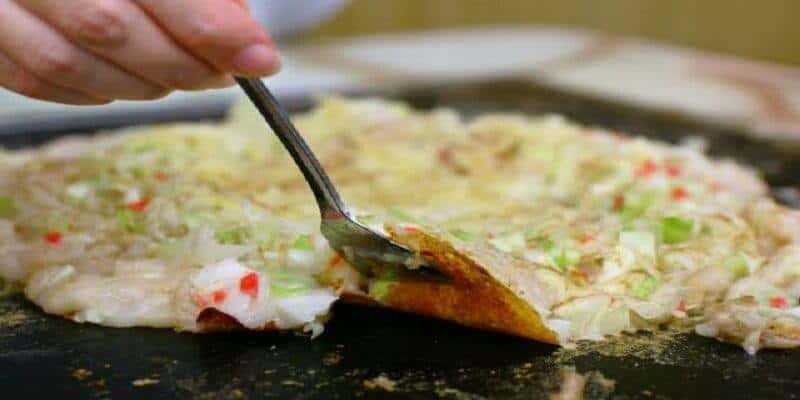
The answer is no. Although this pancake dish is originally from Tokyo, Monjayaki is also available in other prefectures. Monja from other prefectures are almost similar. However, there can be a little difference too. Curious to know which areas have Monjayaki too? Check the list below then.
Kagawa Prefecture
Sanuki Monjayaki is the name of Kagawa’s version. Since the prefecture is famous for its Sanuki Udon, they named their monja after it. Therefore, the name Sanuki Monjayaki began. It is now one of the local dishes in Kagawa Prefecture.
Saitama Prefecture
In Saitama, Monjayaki is a children’s snack. Several candy stores are selling this until late 1980s. Nowadays, it is very rare these to see these stores.
Tochigi Prefecture
Tochigi’s “Ashikaga Monja” is the prefecture’s version of Monjayaki. Similarly, locals bake the crepes thinly and uses water and flour only. It also comes in shoyu and worcestershire sauce flavor. Today, only a few shops that offer Ashika Monja is existent.
Gunma Prefecture
Many people believe that the origin of “Isesaki Monjayaki” started due to Gunma is in the middle of Asakusa and Saitama. Hence, the people adapted this dish too.
During early times, there were many poor households in the area. They combined soy sauce, curry powder, and strawberry syrup to make the monja’s sauce.
Monjayaki Recipe

We will learn about monjayaki recipe but first let’s get to know all the ingredients. Monjayaki ingredients that locals typically used are pork, squid, scallops, shrimp, egg, clams, oysters, tuna, cheese, corn, cod roe. They also add a variety of vegetables like cabbage and carrots.
How to Make Monjayaki?
You now know what are the ingredients needed, so now, you will learn how to make monjayaki.
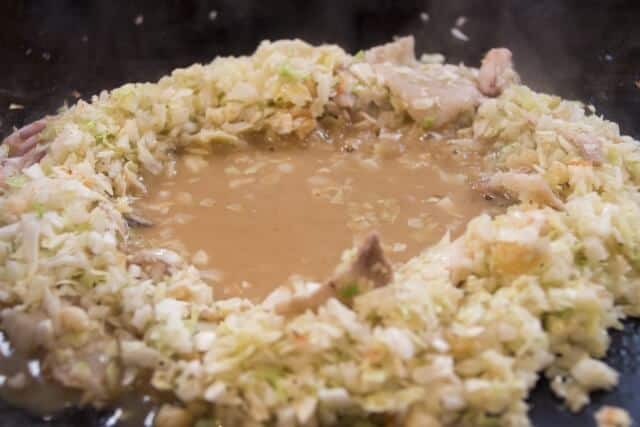
We begin with a bowl of ingredients that are chopped up and ready to grill.
You spread oil on the iron plate and let it get hot before you start placing the ingredients in. You will be using the spatula to mix and stir-fry the ingredients together.
Then make the batter with a mix of flour, water, and sauce-like Worcestershire sauce or soy sauce.
Spread the ingredients into a donut shape and pour the batter into the middle, so it is surrounded and will not leak out.
Once the batter starts to boil, you can mix all the ingredients and spread them around. It will start looking half-cooked which makes it time to eat.
Pressing the food down into the grill with the spatula allows for it to stick easier to it too. You can serve it with Japanese mayonnaise or Tonkatsu sauce to top it off with a bonus flavor.
Monjayaki vs Okonomiyaki
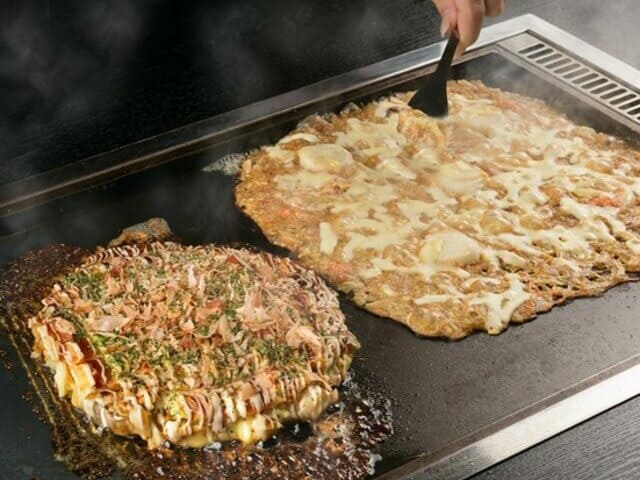
While okonomiyaki is popular in the Kansai and Hiroshima area, monjayaki is popular in the Kanto (Tokyo) area. Okonomiyaki batter has all the ingredients mixed and molded into a pancake-like shape when cooked. Then, the Japanese topped it with sauce, mayonnaise, dry seaweed, and other condiments like bonito flakes for flavor. Monjayaki batter is softer and locals spread it evenly throughout the iron plate. The batter consists of mixing wheat flour with Worcester sauce and dashi stock, so it is watery and runny.
How to eat monjayaki?
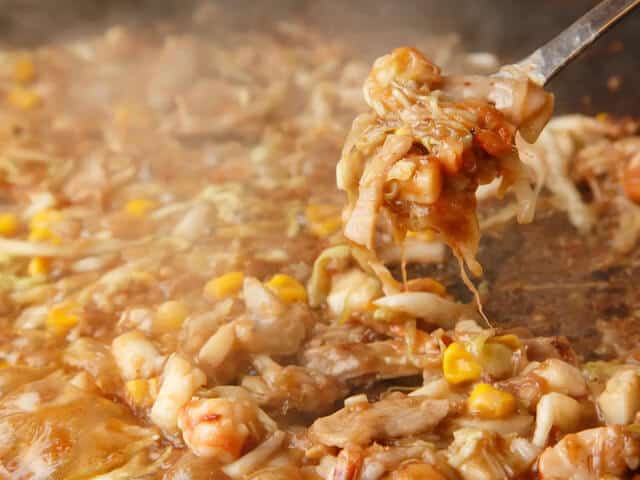
Because locals make monjayaki by cooking the main ingredients first, spreading them into a circle on the grill, and then pouring the batter into the center. They often eat it when it is partially or half-cooked, using a spatula-shaped spoon.
What does Monjayaki taste like?

The flavor of monjayaki resembles that of okonomiyaki, possibly due to the sauce, but the consistency sets them apart; monjayaki is soft and reminiscent of scrambled eggs, whereas okonomiyaki has a crispier texture. Despite this difference, the taste of monjayaki was a delightful surprise.
Recommended Monjayaki Restaurants
When dining at a restaurant, you can savor the delicious grilled food either by cooking it yourself on a hot iron plate or having it prepared in front of you by the chef. Tokyo offers a vibrant street full of restaurants specializing in this unique dining experience known as monja. With a wide selection of raw ingredients to choose from, you can customize your meal to suit your preferences. Don’t miss out on trying this must-have dish when visiting Tokyo for an unforgettable culinary adventure.
Rokumonsen
Asakusa Rokubunsen is a long-established Asakusa monjayaki restaurant founded in 1980 (Showa 55). The restaurant is known for its traditional taste and atmosphere, numerous media mentions, popular Camembert Monja and the ability to accommodate large groups.
Asakusa Rokubun Sen is also known as a restaurant that embodies the downtown culture of Asakusa. The humanity of the downtown area, simple flavours, a strong local presence, traditional production methods and a downtown atmosphere are the hallmarks of this long-established restaurant.
Monja Kura

You want your first experience to be in a popular shop? Then look no further than one of the most famous monja restaurants, Kura. With a rich menu, you can experience more than just Monjayaki here. Inexperienced hands can get help in using the table’s iron plate. Hence. their monjayaki is tasteful and satisfying. The menu outside can help you choose while your waiting too. Many people will say it is worth the wait.
Meibutsu Monja Daruma

Feel the history of downtown Tokyo here in this enjoyable and retro shop. It is old, but renovated house that serves an abundant food menu. Enjoy a nice cup of sake with your monjayaki that you can make yourself or ask the staff to do it. Consequently, do not forget to try a dessert that is also made on the iron plate. A whole fun experience and nice drinks that are catered to women. To beat the queue for this busy restaurant, a reservation is best.
Monja Mammaru

Reserve a seat at this shop to eat as much as you want for one price. All-you-can-eat places are growing in popularity. This one has all you can drink as well. If you are really hungry and want to try monjayaki, then this is the place for you. You will satisfy your hunger here and enjoy the great experience of using an iron plate.
Conclusion
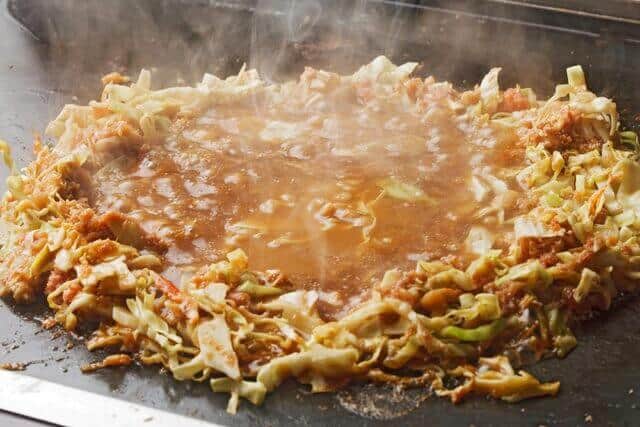
When it comes to Japanese cuisine, most individuals tend to associate it with sushi, sashimi, and even popular comfort foods like okonomiyaki or udon noodles. However, a well-liked dish called Monjayaki has been enjoyed by many locals in downtown Tokyo for generations. In recent times, the number of specialized eateries offering this dish has been increasing, turning it into a noteworthy attraction for tourists.






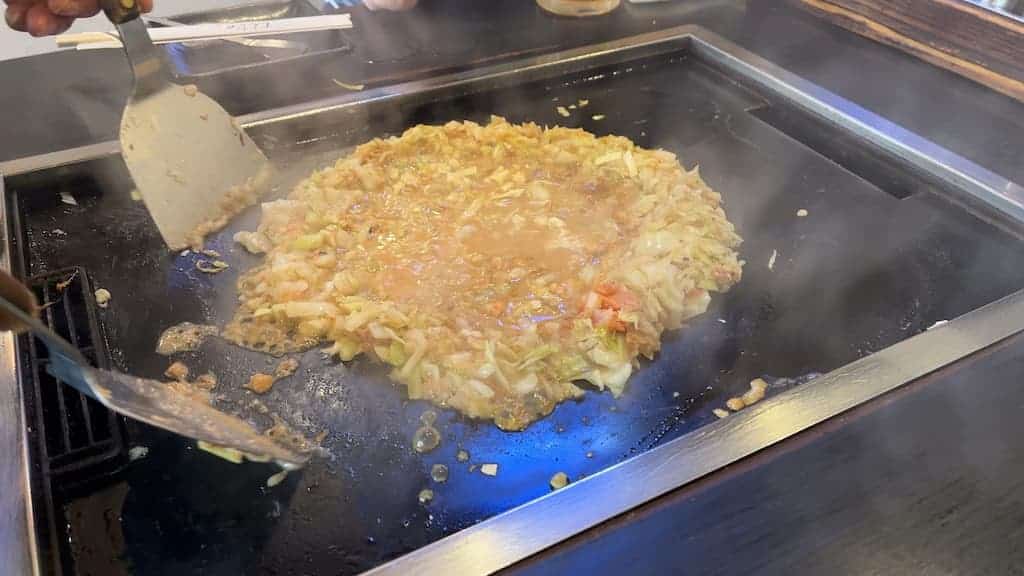




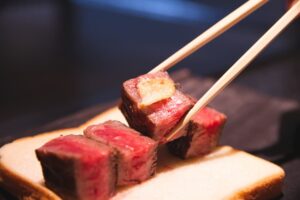




Comments
List of comments (2)
Thanks for this! I never knew what Monjayaki was and this is very informative!
thank you for reading!!
If you have something you want to know about Japanese food.
feel free to ask! 🙂